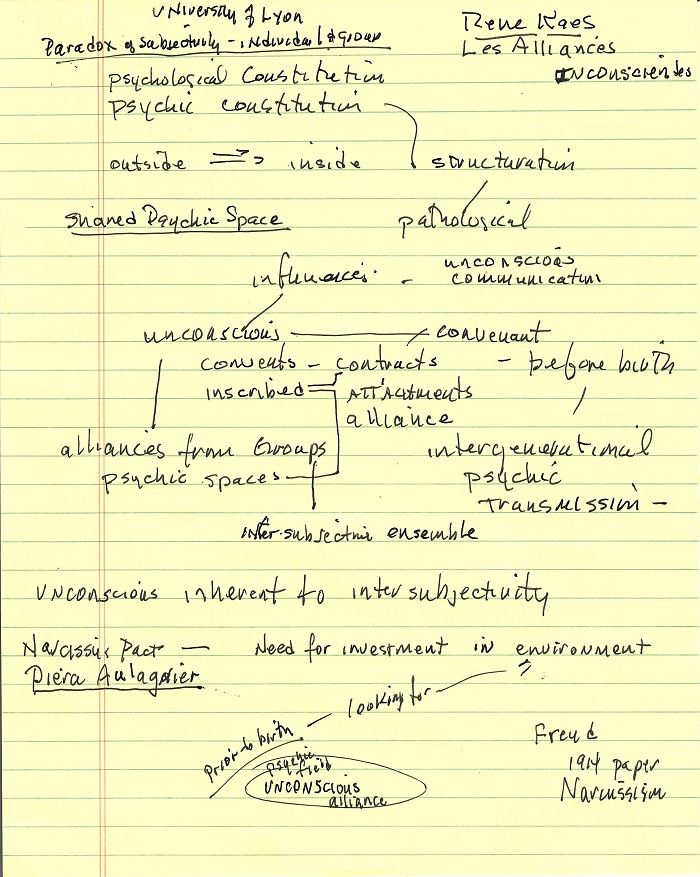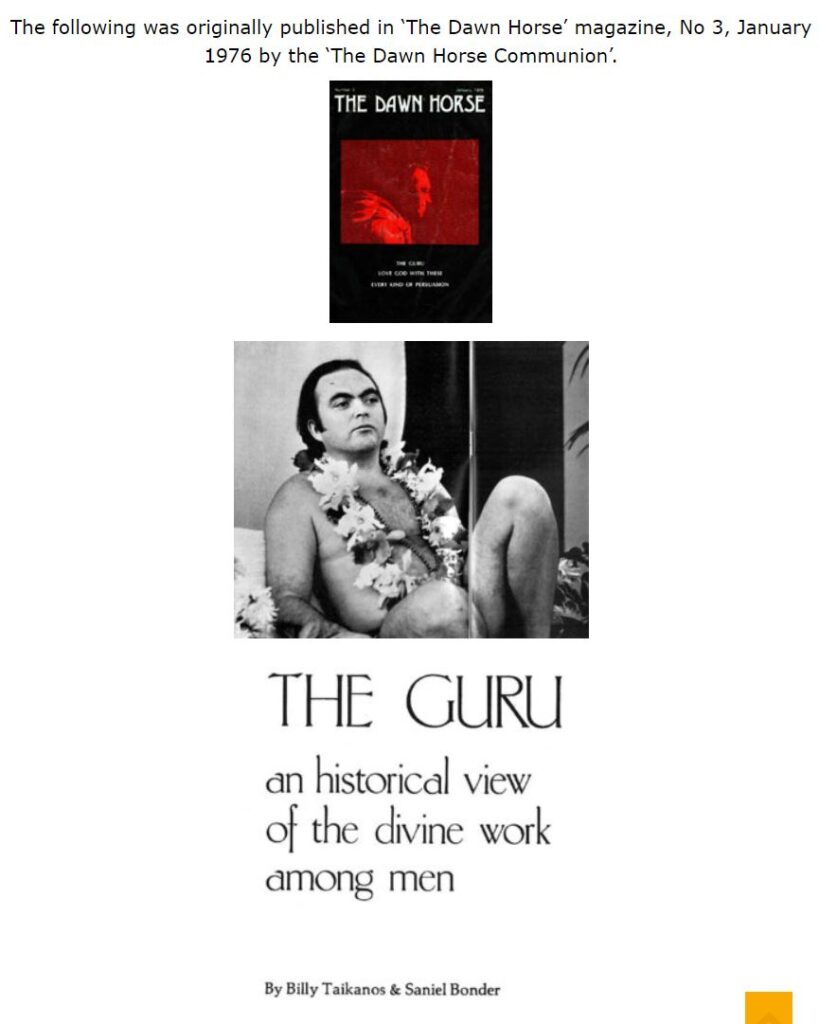Adaption by Beezone from a Talk Given by Adi Da Samraj On November 20, 1975 on the function of the Guru.

Bubba Free John (Adi Da Samraj): Individuals who take on the role of Guru in this world often have a history of connections with many people and an eternal responsibility for others. This responsibility exists even when there’s no prior connection. Associations come in various forms—some seem more intimate due to past connections, while others become intimate because of an eternal connection without previous familiarity.
The Guru essentially comes for those who are considered his own. Anyone fulfilling the Guru function acts as a specific agency. The realization of the Guru is rooted in Eternal Nature and Condition, yet each Guru is a distinct agent. Not everyone, in this sense, becomes a devotee of the Guru when he appears. It’s possible for everyone on Earth at a given moment to fundamentally belong to such an agent, but the variations are complex.
In the cosmic context and the laws of manifestation, things are inherently complicated, not straightforward. This complexity leads to various karmic complications, creating diverse theatrics unrelated to the gross world but connected to an intricate stream of associations.
People perceive a Guru, whether alive or an idea in their mind, with various theatrics. This complexity makes it challenging for some individuals to consider such a person.
DEVOTEE: Would the presence of devotees make it easier for others to consider spiritual practice (sadhana)?
BUBBA: Yes, because people are primarily influenced by gross and ordinary factors. The Ashram itself doesn’t necessarily represent everyone for whom I have a responsibility. Some may come to the Ashram but cannot endure it, while others may not engage in sadhana during my lifetime but may do so later. It’s a complex situation.
The Guru’s influence is most potent with those most available to him. As disciples mature in their sadhana, the influence is re-established in more ordinary forms closer to what people are sensitive to. When mature disciples and devotees appear, the Guru’s influence magnifies and simplifies.
The sadhana of individuals appears simpler over time as the grosser elements become natural. From the outside, it may seem easier, but the profound responsibility remains. The intensity of the practice often intensifies when viewed externally.
DEVOTEE: Is physical presence necessary for someone to meet you?
BUBBA: Ultimately, direct contact while I’m alive is necessary. After my passing, adaptation to the sadhana alive in the Ashram through devotees is crucial. Some may be alive during my time but never meet me.
DEVOTEE: It’s humorous how some people suddenly leave the Ashram, unable to meet the conditions at that time.
BUBBA: Indeed, some have karmas that prevent even fulfilling basic conditions. Life’s manifest existence is ridiculous and full of weird adjustments.
The force of Satsang reveals hidden qualities, requiring a full experiential dimension. It’s not just subjective; external life must be seen totally.
In perfect adaptation to the Guru in Satsang, some endurance in the body is necessary. The quality of the approach determines how much must be endured.
DEVOTEE: Do institutionalized wrong dharmas hinder people’s availability?
BUBBA: Yes, those attracted to such institutions are influenced by their karmic tendencies. Criticism should focus on aspects that mislead and draw away from the higher process, not heavy political approaches.
The Guru’s function is not about saving the world but making himself available to those willing to do sadhana. It’s about availability and dealing with those who come, not a grand program of world salvation.
The Guru’s work involves adapting to various karmic individuals, and it requires intelligence, not a utopian vision. There are karmas even in the Guru’s work, involving absolute responsibility and dealing with individuals.
In summary, this Teaching is not universally accepted, and the Guru’s role is about making sadhana accessible to those who seek it, not saving the world.
Further study
More:
BUBBA: In The Method of the Siddhas, in the very last section of the book, there’s a letter there that I sent to the Ashram.
Those who fulfill the agency of Guru in this plane have a history of connection with many individuals also have the eternal responsibility for others, without a history of connection with them in any sort of previous circumstance.
There’re many different kinds of association, some of which seem more intimate because of past association in some form, others in which become intimate because of the eternal connection which has no familiarization previous to that time.
***
Psychologically speaking:
The recognition of the alienation of subjectivity, compromised by a defective generational psychic transmission, makes way to a fresh clinical look into the pathologies of Modernity.
The transmission processes are sustained by identification mechanisms within an interplay of projections-introjections and incorporations, as well as by a reference to the parental superego. The generational psychic transmission that needs to be metabolized and undergo transformations takes place within the bounds of this intersubjective psychic space. The traumatic traces and narcissistic wounds which are transmited as remainders of the “negative”, without modification and repetitively, in the various bonds of the family group space, are taken into consideration in family group practice. These traces and wounds are responsible for a number of symptoms as well as intra and intersubjective suffering. – Olga B. Ruiz Correa
***
The Unconscious Alliance and the Narcissistic Contract in the Psychic Constitution – Ludmilla Tassano Pitrowsky
***
Other References
1. Kaës R (2009) Les aliances inconscientes. 1st (edn.), Ideas and Letters Publishing
House, Brazil, pp. 1-328.
2. Aulagnier P (1979) A violência da interpretação: Do pictograma ao enunciado.
In: Imago (ed.), Brazil.
3. Freud S (1996) Sobre o narcisismo: Uma introdução. In: Imago (ed.), Standard
Brazilian Edition of the Complete Psychological Works of Sigmund Freud,
Brazil, 14: 75-110.
4. Junqueira C, Junior NC (2017) Acerca da metapsicologia dos limites. Ágora (Rio
J) 20(1): 85-101.
5. Kaës R (2006) Common and shared psychic spaces: Transmission and negativity.
1st (edn.), Psychology and Psychoanalysis.
6. Kaës R (2011) A plural singular: Psychoanalysis to the test of the group. 1st
(edn.), Edições Loyola, pp. 1-248.
7. Kaës R (2004) A polifonia do sonho. Aparecida, SP: Ideias&Letras.
8. Kaës R (2003) The polyphony of the dream and its two navels. The common and shared oneiric spaces. Revista da Spagesp 4(4): 1-14.
9. Correa OBR (2001) Transmissão da vida psíquica entre gerações. Casa do
Psicólogo, Brazil.
Beezone worksheet
